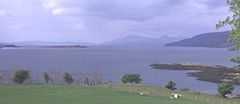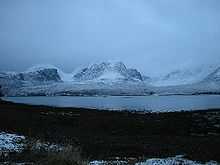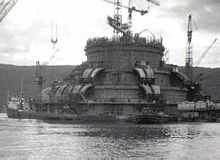Loch Kishorn
| Loch Kishorn | |
| Scottish Gaelic: Loch Ciseòrn | |
 Loch Kishorn from near Sanachan |
|
 Loch Kishorn |
|
| OS grid reference | NG785348 |
|---|---|
| Council area | Highland |
| Lieutenancy area | Ross and Cromarty |
| Country | Scotland |
| Sovereign state | United Kingdom |
| Postcode district | IV54 8 |
| Police | Scottish |
| Fire | Scottish |
| Ambulance | Scottish |
| EU Parliament | Scotland |
Coordinates: 57°21′00″N 5°40′59″W / 57.35°N 5.683°W
Loch Kishorn (Scottish Gaelic: Loch Ciseòrn) is a sea loch in the north-west Highlands of Scotland. For more information on Kishorn go to www.kishornonline.co.uk
Topography
Loch Kishorn is a northern branch of Loch Carron about 1 mile (1.6 km) wide and 2.5 miles (4 km) long, and with a maximum recorded depth of about 200 feet (61 m) although some parts of the loch are at a depth of 100 metres and more. It is fed by the River Kishorn which flows from the north and enters through an estuary about 1.5 miles (2.4 km) long and almost 0.6 miles (1 km) wide. To the north and west of the loch is the Applecross peninsula; to the east is a headland that separates it from upper Loch Carron. The mouth of the loch is marked by the Garra Islands, the largest of which is Kishorn Island.
There are three small settlements strung along the eastern end of the loch. It is common to refer to the three collectively as Kishorn.
Sanachan is a little inland at the head of the loch. It contains a small gift shop, "Patterns of Light", the award winning "Kishorn Seafood Bar" and a Scottish Episcopal chapel. The A896 road passes through Sanachan, and a minor road leads off to the other settlements. Ardarroch is on the lochside, next to small shingly beach. The final settlement, Achintraid, is further down the loch. It consists of a line of whitewashed cottages, originally built to house crofters evicted in the Highland Clearances. Achintraid is noted for spectacular views of the Applecross peninsula, with the Corbetts of Sgurr a' Chaorachain and Beinn Bhàn and the pass of the Bealach na Ba being particularly prominent.
East of Kishorn are two small Marilyns: An Sgurr and Bad a' Chreamha.
Kishorn Yard

Kishorn Yard was a fabrication yard at Loch Kishorn for oil platforms. The yard was owned by Howard Doris and operated from 1975 to 1987. In 1975 work began on the construction yard and dock for the production of oil platforms on the north side of the loch. This lay at the end of a 2-mile (3 km) stretch of road built to provide access in just 12 days, and by 1977 over 3,000 people were working here, housed in temporary accommodation on site and in two accommodation ships moored in the loch: the former car ferries Rangatira and Odysseus.
The largest project involved the excavation of a huge dry dock, in which the 600,000 tonne Ninian Central Platform was built in 1978. Material was supplied by sea and when complete the platform needed seven tugs to tow it to its operating position in the North Sea. The Ninian Central Platform still holds the record as the largest movable object ever created by man.
Loch Kishorn is very deep, technically being a fjord, and the yard was therefore well suited to build the concrete Ninian Central Platform, once the World's largest man-made moveable object.

Mindful of the controversy surrounding an earlier proposal to develop a yard at Drumbuie, a condition of the planning permission was that the site had to be treated as an island: a self-contained village for 2,000 workers was created, and all deliveries would arrive by sea, rather than by road. A depot for transferring deliveries from rail to sea was built at Stromeferry, on the Kyle of Lochalsh Line. These conditions, though slightly relaxed by the end of the yard's life, had the intended effect of not altering the surrounding area much, though some might have liked it if money had instead been spent on improving the poor, usually single track, roads in the area.
By 1980 the construction yard was diversifying in an effort to escape a downturn in oil exploration and production, but its days were numbered. Two thousand people were still employed in 1984, but bankruptcy in 1986 was followed by closure in 1987 and clearance of most of the buildings on the site.
In 1992 the dry dock was put to use in the construction of the 2,300 tonne bridge footings for the Skye Bridge that links Kyle of Lochalsh with the Isle of Skye.
The 120m quay is used by Ferguson Transport as a port for fish farming supplies, forestry products, round wood, road salt and fertilizer.[1]
In 2006, Leiths (Scotland) Ltd commenced quarrying operations on the site, supplying concrete for precast blocks for the Raasay Ferry Terminal. Leiths and Ferguson Transport have created a new joint venture company, Kishorn Port Limited to promote the regeneration of the Yard and the dry dock as a manufacturing centre for the offshore renewables industry.[2]
One lasting impact is the Howard Doris Trust. Amongst other things, it has provided a lot of funding for the Howard Doris Centre in nearby Lochcarron, which provides care for the elderly.
The Kishorn Commandos
Gordon Menzies of the folk band Gaberlunzie wrote a well known song called "The Kishorn Commandos", the chorus to which is:
- We're the Kishorn Commandos way up in Wester Ross
- We've never had a gaffer, we've never had a boss
- But we'll build the biggest oil-rig you've ever come across
- Remember we're the Kishorn Commandos
HMP Kishorn
The now defunct Scottish independence group had put forward plans for a temporary prison to be placed on otherwise empty oil platforms as a solution to prison overcrowding.
External links
- grid reference NG813395 - Kishorn Yard
- grid reference NG838400 - Sanachan
- grid reference NG836397 - Ardarroch
- grid reference NG835387 - Achintraid
References
- 2528 Loch Gairloch, Loch Kishorn and Loch Carron (Map) (2007 ed.). UK Hydrographic Office.
www.kishornonline.co.uk